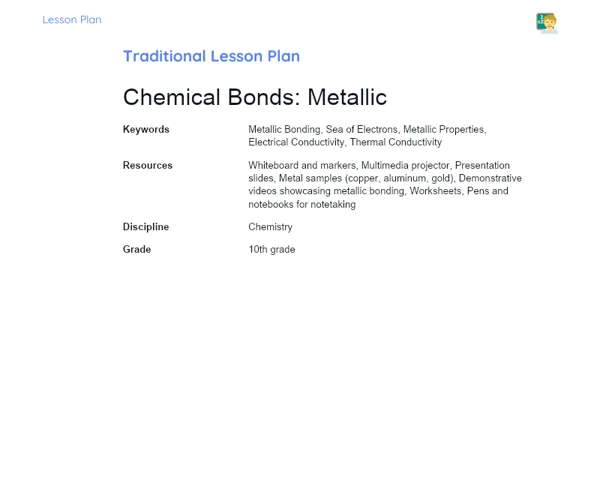Lesson Plan Teknis | Organic Functions: Amide Nomenclature
| Palavras Chave | Amides, IUPAC Nomenclature, Naming of organic compounds, Pharmaceutical industry, Synthetic materials, Molecular models, Organic chemistry, Hands-on construction, Experimental skills, Scientific communication |
| Materiais Necessários | Short video on the use of amides, Molecular model kits, Recyclable materials (toothpicks, modeling clay), List of amides (methanamide, ethanamide, propanamide), Whiteboard and markers, Computer and projector, Supporting materials on IUPAC nomenclature |
Objective
Duration: 10 to 15 minutes
This stage of the lesson plan aims to help students appreciate the significance and practical use of amide nomenclature. By honing practical and experimental skills, students will be well-equipped for real-world scenarios, whether in academics or their future careers, where accuracy in the nomenclature of organic compounds is vital.
Objective Utama:
1. Recognize and correctly name the IUPAC nomenclature for amides.
2. Differentiate the nomenclature of amides from other organic compounds.
Objective Sampingan:
- Build practical skills in identifying and naming amides.
- Use acquired knowledge in real-world and professional settings.
Introduction
Duration: 10 to 15 minutes
This stage strives to instill the importance and practical application of amide nomenclature in students' minds. By nurturing practical and experimental skills, students will be better prepared for real-world applications, whether in academic or professional environments, where correct nomenclature is key.
Curiosities and Market Connection
Amides play a critical role in the pharmaceutical industry as main ingredients in medications like paracetamol. They are also used to create high-strength polymers such as nylon, which is widely employed in producing clothing and industrial goods. Mastering amide nomenclature empowers professionals in chemistry and engineering to develop new materials and medications more effectively.
Contextualization
Amides are key organic compounds commonly found in various sectors, from pharmaceuticals to the manufacturing of synthetic materials. Understanding amide nomenclature is not just theoretical knowledge; it's a crucial practical skill that can be applied in chemical labs, the pharmaceutical industry, and scientific research. Accuracy in nomenclature is essential for the correct identification and application of these compounds.
Initial Activity
Kick off the lesson with a brief video (2-3 minutes) showcasing the role of amides in creating medicines and industrial materials. Following the video, pose the thought-provoking question to the students: 'How does precision in the nomenclature of organic compounds influence the development of new medicines?'
Development
Duration: 55 to 65 minutes
This stage aims to deepen students' understanding of amide nomenclature through hands-on activities and reflection. By constructing molecular models, students will gain a more concrete insight into the structures of amides and nomenclature rules while also enhancing their collaborative and communication skills.
Topics
1. Definition of amides
2. Molecular structure of amides
3. IUPAC nomenclature guidelines for amides
4. Distinctions between amides and other organic compounds
Thoughts on the Subject
Encourage a discussion regarding the significance of precision in amide nomenclature for developing new materials and medicines. Ask students how a robust understanding of nomenclature can influence scientific and industrial research, citing examples from the pharmaceuticals and synthetic materials sectors.
Mini Challenge
Building Molecular Models of Amides
Students will create molecular models of different amides using molecular model kits or recycled materials to understand the structure and nomenclature of these compounds better.
1. Divide the class into groups of 3-4 students.
2. Hand out molecular model kits or recyclable materials (like toothpicks and clay) to each group.
3. Provide a list of amides (e.g., methanamide, ethanamide, propanamide) for each group to select one and build.
4. Guide the groups to construct the molecular model of their chosen amide, adhering to the IUPAC nomenclature rules.
5. Instruct each group to write the structural formula and IUPAC name of their constructed amide, detailing the naming process.
6. Post-construction, have each group present its model to the class, explaining the nomenclature and structure of their amide.
Enhance practical skills in building molecular models and reinforce understanding of IUPAC nomenclature rules for amides.
**Duration: 30 to 35 minutes
Evaluation Exercises
1. List three amides and provide their correct IUPAC names.
2. Contrast the nomenclature of amides with other organic functional groups, like carboxylic acids and amines, offering examples.
3. Illustrate with examples how IUPAC nomenclature can prevent misunderstandings in scientific communication.
Conclusion
Duration: 10 to 15 minutes
The purpose of this final stage is to solidify the knowledge gained, linking theory with practice while encouraging students to think about its application in real contexts. This conclusion aims to highlight the relevance of the topic for their academic journeys and future careers.
Discussion
Facilitate a conversation among students about how precise amide nomenclature affects the creation of new materials and medicines. Encourage them to share how the practical activity helped them grasp the IUPAC rules better, and discuss real-world applications in industries like pharmaceuticals and synthetic materials.
Summary
Summarize the key points covered, such as the definition of amides, their molecular structures, the IUPAC nomenclature rules, and distinctions between amides and other organic compounds. Highlight the importance of precise nomenclature in fostering effective scientific communication and in developing new products.
Closing
Emphasize that mastering amide nomenclature is vital not only for academic assessments but also for professional endeavors across various fields, including industrial chemistry and scientific research. Stress that the knowledge acquired today can serve as a strong asset in the job market, especially in crafting new medications and materials.



